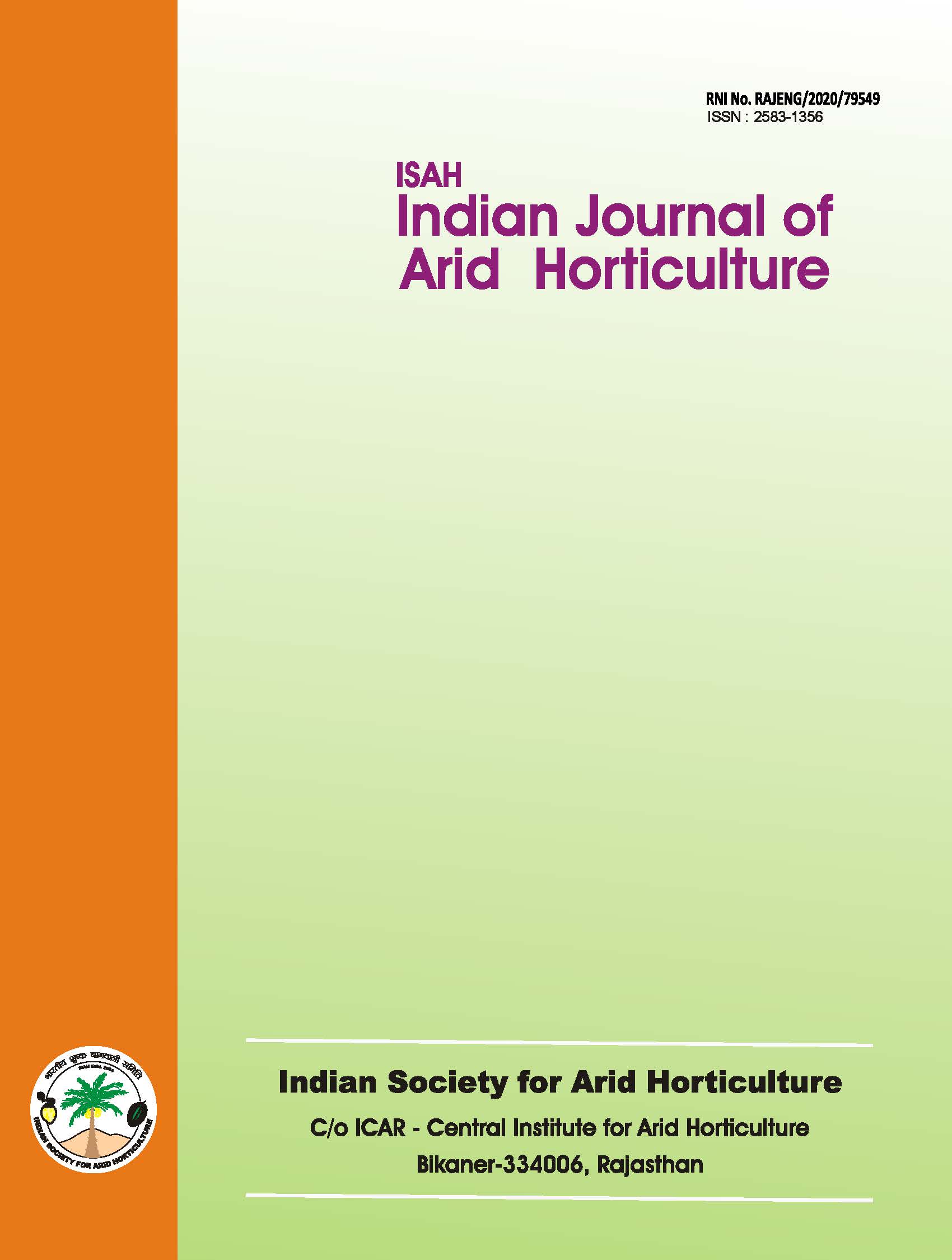Efficient use of drumstick in multitier cropping system under semi-arid ecosystem
Keywords:
Drumstick, cropping system, cucurbitsAbstract
To achieve the projected target of 220 MT of vegetable production by 2020, augmentation in vegetable production needs to be formulated for different cropping system to fully exploit the natural resources. Number of cropping systems have been developed for different ecosystems, however, a suitable vegetable based cropping system is lacking for semi-arid and arid ecosystem. Considering the nature of growth pattern of the component crops and their yield potential, drumstick (base crop) and cucurbits (climbers) have been chosen in the cropping system. An experiment comprising eleven treatments with three replications in randomized block design was conducted at Central Horticultural Experiment station, Vejalpur from 2004- 05 and 2005-06. The results revealed that the interaction of component crops did not significantly reduce the growth parameters of base crop (drumstick) over sole crop. Higher the cropping index (200%), drumstick equivalent yield (28.65 kg/ ha) and land equivalent ratio (2.39) has been observed in the treatment combining drumstick and ridge gourd. This multitier system reduced the cost of input by 70.1 and 64.0 per cent comparing bower system and local system respectively.Downloads
References
Abuselakha, and Dutta, O.P. (1995). Effect of different training systems on growth and yield of sponge gourd. Indian Journal of Horticulture, 52(1): 60-63.
Hegde, M.R., Yasuf, M., and Gopalasundaram, P. (1993). Intercropping vegetables in coconut gardens. In: Advances in Coconut Research and Development (eds. Nair, M.K., Khan, H.H., Gopalasundaram, P., Bhaskararao, E.V.V.), Oxford and IBH Publishing Co., New Delhi, pp. 407-412.
Fukai, S., and Trenbath, B.R. (1993). Processes determining intercrop productivity and yields of component crops. Field Crop Research, 34: 247-271.
Kulbir Singh, Sandhu, K.S., and Sandhu, M.S. (2001). Intercropping of sweet pepper with radish, cabbage, and onion. Vegetable Science, 28(2): 137-139.
Muoneke, C.O., and Asiegbu, J.E. (1997). Effect of okra planting density and spatial arrangement in intercrop with maize on the growth and yield of the component species. Journal of Agronomy and Crop Science, 179: 201-207.
Nagwekar, D.D., Haldankar, P.M., Desai, A.G., Gunjate, R.T., and Rajput, J.C. (1997). Performance of rainfed vegetables as intercrops in coconut plantation. Journal of Plantation Crops, 25(2): 209-211.
Palada, M.C. (1996). Moringa (Moringa oleifera Lam.): A versatile tree crop with horticultural potential in the subtropical United States. HortScience, 31(5): 794-797.
Patil, J.L., Haldankar, P.M., and Jamadagni, B.M. (1992). Intercropping of vegetables in coconut gardens. Journal of Plantation Crops, 20(2): 167-169.
Rajangam, J., et al. (2001). Status of production and utilization of Moringa in Southern India. In Development Potential for Moringa Products, October 29th-November 2nd, 2001, Dar es Salaam, Tanzania.
Ramachandran, C., Peter, K.V., and Gopalakrishnan, P.K. (1980). Drumstick (Moringa oleifera): A multipurpose Indian vegetable. Economic Botany, 34(3): 276-283.
Reddy, V.M., Baranwal, V.K., and Singh, R.K. (1993). Arecanut based high-density multispecies cropping system in West Bengal. Journal of Plantation Crops, 21: 15-21.
Sidhu, A.S. (2002). Current status of vegetable research in India. Tropical Seeds (Internet), page 9 of 12.
Shivaramu, H.S., and Shivshankar, K. (1992). Performance of sunflower and soybean in intercropping with different population and planting patterns. Indian Journal of Agronomy, 37(2): 231-236.
Singh, K., Sandhu, K.S., and Sandhu, M.S. (2001). Intercropping of sweet pepper with radish, cabbage, and onion. Vegetable Science, 28: 137-139.
Vandermeer, J. (1989). The Ecology of Intercropping. Cambridge University Press, Cambridge, UK, p. 237.
Willey, R.W. (1979). Intercropping—its importance and yield advantages. Field Crops Abstracts, 32: 1-10.

